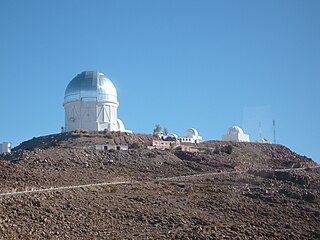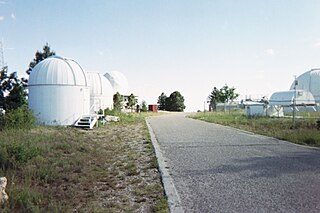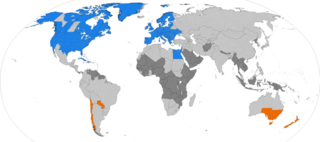
The McDonald Observatory is an astronomical observatory located near the unincorporated community of Fort Davis in Jeff Davis County, Texas, United States. The facility is located on Mount Locke in the Davis Mountains of West Texas, with additional facilities on Mount Fowlkes, approximately 1.3 kilometers (0.81 mi) to the northeast. The observatory is part of the University of Texas at Austin. It is an organized research unit of the College of Natural Sciences.

The Apache Point Observatory is an astronomical observatory located in the Sacramento Mountains in Sunspot, New Mexico, United States, approximately 18 miles (29 km) south of Cloudcroft. The observatory is operated by New Mexico State University (NMSU) and owned by the Astrophysical Research Consortium (ARC). Access to the telescopes and buildings is private and restricted.

The Cerro Tololo Inter-American Observatory (CTIO) is an astronomical observatory located on Cerro Tololo in the Coquimbo Region of northern Chile, with additional facilities located on Cerro Pachón about 10 kilometres (6.2 mi) to the southeast. It is within the Coquimbo Region and approximately 80 kilometres (50 mi) east of La Serena, where support facilities are located. The site was identified by a team of scientists from Chile and the United States in 1959, and it was selected in 1962. Construction began in 1963 and regular astronomical observations commenced in 1965. Construction of large buildings on Cerro Tololo ended with the completion of the Víctor Blanco Telescope in 1974, but smaller facilities have been built since then. Cerro Pachón is still under development, with two large telescopes inaugurated since 2000, and one in the early stages of construction.

Space Place at Carter Observatory is housed in a historic astronomical observatory located at the top of the Wellington Botanic Garden in Wellington, New Zealand.

South African Astronomical Observatory (SAAO) is the national centre for optical and infrared astronomy in South Africa. It was established in 1972. The observatory is run by the National Research Foundation of South Africa. The facility's function is to conduct research in astronomy and astrophysics. The primary telescopes are located in Sutherland, which is 370 kilometres (230 mi) from Observatory, Cape Town, where the headquarters is located.

Mount Laguna Observatory (MLO) is an astronomical observatory owned and operated by San Diego State University (SDSU). The telescope was operated in partnership with the University of Illinois at Urbana-Champaign (UIUC) until 2000. MLO is located approximately 75 kilometers (47 mi) east of downtown San Diego, California (USA) on the eastern edge of the Cleveland National Forest in the Laguna Mountains and near the hamlet of Mount Laguna. MLO was dedicated on June 19, 1968, seven years after SDSU's Department of Astronomy became an independent academic department of SDSU's College of Sciences. The dedication took place during the 1968 summer meeting of the Astronomical Society of the Pacific.

The Royal Observatory, Edinburgh (ROE) is an astronomical institution located on Blackford Hill in Edinburgh. The site is owned by the Science and Technology Facilities Council (STFC). The ROE comprises the UK Astronomy Technology Centre (UK ATC) of STFC, the Institute for Astronomy of the School of Physics and Astronomy of the University of Edinburgh, and the ROE Visitor Centre.

Foothill Observatory is an astronomical observatory owned and operated by Peninsula Astronomical Society and Foothill College. It is located on the college's campus in Los Altos Hills, California (US). The observatory is used by students enrolled in the introductory astronomy lab on campus, which is part of the college's thriving astronomy for non-scientists program, serving over 800 students per year. It is also used for public viewing one evening a week. A new 16-inch (410 mm) telescope was donated to the observatory and went into operation in 2007. The observatory is generally open to the public without charge every clear Friday night from 9 to about 11 pm.

The Robinson Observatory is an astronomical observatory owned and operated by the University of Central Florida College of Sciences in Orlando, Florida, USA.

Bowman Observatory is an astronomical observatory owned and operated by the Greenwich, Connecticut Board of Education.

Apollo Observatory is an astronomical observatory owned by Boonshoft Museum of Discovery and operated by the Miami Valley Astronomical Society at Boonshoft Museum of Discovery. The observatory is located at Boonshoft Museum of Discovery in Dayton, Ohio, United States.

Mount Lemmon Observatory (MLO), also known as the Mount Lemmon Infrared Observatory, is an astronomical observatory located on Mount Lemmon in the Santa Catalina Mountains approximately 28 kilometers (17 mi) northeast of Tucson, Arizona (US). The site in the Coronado National Forest is used with special permission from the U.S. Forest Service by the University of Arizona's Steward Observatory, and contains a number of independently managed telescopes.

Melbourne Observatory was founded in 1862 to serve as a scientific research institution for the rapidly growing city of Melbourne, the capital of the colony of Victoria. The observatory was tasked by the Victorian government with maintaining an accurate time reference for the colony through observations of stars using a transit telescope as well as general astronomical research.
The Hamilton Astronomical Society Observatory is located next to the Hamilton Zoo in Brymer Road to the west of Hamilton City, New Zealand. The Hamilton Astronomical Society was founded in 1933 and is one of New Zealand's oldest astronomical societies.

Coats Observatory is Scotland’s oldest public observatory. It is currently closed for refurbishment as part of a 4 year long £42m transformation of the observatory and museum buildings. Located in Oakshaw Street West, Paisley, Renfrewshire, the observatory has been operational since 1 October 1883 and continues to function to this day, offering visitors the opportunity to view the night sky through the powerful telescopes housed within the building.

Fuertes Observatory is an astronomical observatory located on the North Campus of Cornell University in Ithaca, New York. The observatory was designed by L.P. Burnham, Cornell Professor of Architecture and completed in fall of 1917. It was originally used by the Civil Engineering Department as an instructional field office for navigation and surveying. Today, the observatory is primarily used for public outreach, welcoming over two thousand visitors per year with open houses on clear Friday nights.
The Dunedin Astronomical Society Incorporated (DAS) is an amateur astronomical group operating from the Beverly-Begg Observatory Dunedin, New Zealand. It is affiliated with the Royal Astronomical Society of New Zealand and with the Otago Institute.

The Eileen M. Collins Observatory is a small astronomical observatory operated by Corning Community College in Corning, New York. It is named for astronaut Eileen Collins. The observatory is primarily used to teach astronomy classes, but the college also provides weekly viewing sessions for the public.

The Quito Astronomical Observatory is a research institute of EPN, the National Polytechnic School in Quito, Ecuador. Its major research fields are astronomy and atmospheric physics.




















